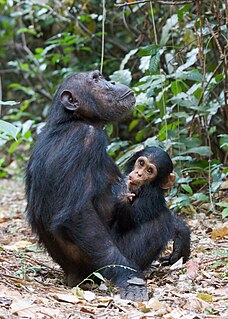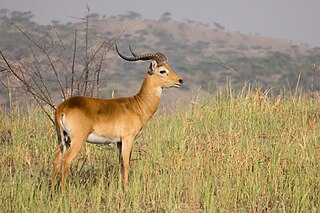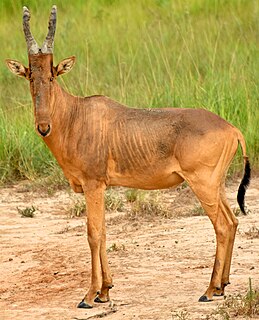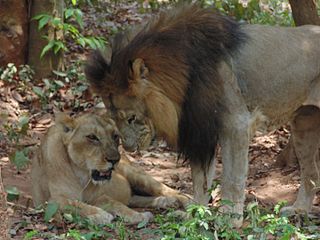 W
WThe African wildcat is a small wildcat species native to Africa, West and Central Asia up to Rajasthan in India and Xinjiang in China. The IUCN Red List status Least Concern is attributed to the species Felis silvestris, which at the time of assessment also included the African wildcat as a subspecies.
 W
WThe African wild donkey or African wild ass is a wild member of the horse family, Equidae. This species is believed to be the ancestor of the domestic donkey, which is usually placed within the same species. They live in the deserts and other arid areas of the Horn of Africa, in Eritrea, Ethiopia and Somalia. It formerly had a wider range north and west into Sudan, Egypt, and Libya. About 570 individuals exist in the wild.
 W
WThe hamadryas baboon is a species of baboon from the Old World monkey family. It is the northernmost of all the baboons, being native to the Horn of Africa and the southwestern tip of the Arabian Peninsula. These regions provide habitats with the advantage for this species of fewer natural predators than central or southern Africa where other baboons reside. The hamadryas baboon was a sacred animal to the ancient Egyptians and appears in various roles in ancient Egyptian religion, hence its alternative name of 'sacred baboon'.
 W
WThe Senegal bushbaby, also known as the Senegal galago, the lesser galago or the lesser bush baby, is a small, nocturnal primate, a member of the galago family Galagidae.
 W
WThe Northeast African cheetah is a cheetah subspecies occurring in Northeast Africa. Contemporary records are known in South Sudan and Ethiopia, but population status in Eritrea, Djibouti, Somalia and Sudan is unknown.
 W
WSalt's dik-dik is a small antelope found in semidesert, bushland, and thickets in the Horn of Africa, but marginally also in northern Kenya and eastern Sudan. It is named after Henry Salt, who discovered it in Abyssinia in the early 19th century.
 W
WThe Somali wild dog is a subspecies of African wild dog native to the Horn of Africa. It is similar to the East African subspecies, but is smaller, has shorter and coarser fur and has a weaker dentition. Its colour closely approaches that of the Cape subspecies, with the yellow parts being buff, rather than bright orange, as is the case in the East African subspecies.
 W
WThe eastern chimpanzee is a subspecies of the common chimpanzee. It is native to the Central African Republic, South Sudan, the Democratic Republic of the Congo, Uganda, Rwanda, Burundi, and Tanzania.
 W
WThe dorcas gazelle, also known as the ariel gazelle, is a small and common gazelle. The dorcas gazelle stands about 55–65 cm at the shoulder, with a head and body length of 90–110 cm and a weight of 15–20 kg. The numerous subspecies survive on vegetation in grassland, steppe, wadis, mountain desert and in semidesert climates of Africa and Arabia. About 35,000–40,000 exist in the wild. The extinct Saudi gazelle from the Arabian Peninsula has been previously considered as a subspecies of the dorcas gazelle.
 W
WHeuglin's gazelle, also known as the Eritrean gazelle, is a species of gazelle found east of the Nile River in Eritrea, Ethiopia and Sudan. It was considered a subspecies of the red-fronted gazelle or conspecific with Thomson's gazelle and Mongalla gazelle by some authors in the past. This small gazelle stands nearly 67 cm (26 in) at the shoulder and weighs between 15 and 35 kg. The coat is dark reddish brown with a dark reddish stripe on the flanks, except for the underparts and the rump which are white. Horns, present in both sexes, measure 15 to 35 cm in length.
 W
WThe red-fronted gazelle is widely but unevenly distributed gazelle across the middle of Africa from Senegal to northeastern Ethiopia. It is mainly resident in the Sahel zone, a narrow cross-Africa band south of the Sahara, where it prefers arid grasslands, wooded savannas and shrubby steppes.
 W
WThe grivet, also known as African green monkey and savannah monkey, is an Old World monkey with long white tufts of hair along the sides of its face. Some authorities consider this and all of the members of the genus Chlorocebus to be a single species, Cercopithecus aethiops. As here defined, the grivet is restricted to Ethiopia, Sudan, Djibouti, and Eritrea. In the southern part of its range, it comes into contact with the closely related vervet monkey and Bale Mountains vervet. Hybridization between them is possible, and may present a threat to the vulnerable Bale Mountains vervet. Unlike that species, the grivet is common and rated as least concern by the IUCN.
 W
WThe heart-nosed bat is a species of bat in the family Megadermatidae. It is monotypic within the genus Cardioderma. It is found in eastern Sudan, north Tanzania, and south Zambia. In an experiment conducted in 2017, it was concluded that the heart-nosed bat emit vocalizations or "sing" as a way to establish their foraging areas and actively defend these territories from other bats of the same species.
 W
WThe black-backed jackal is a canine native to eastern and southern Africa. These regions are separated by roughly 900 kilometers.
 W
WThe klipspringer is a small antelope found in eastern and southern Africa. The sole member of its genus, the klipspringer was first described by German zoologist Eberhard August Wilhelm von Zimmermann in 1783. The klipspringer is a small, sturdy antelope; it reaches 43–60 centimetres at the shoulder and weighs from 8 to 18 kilograms. The coat of the klipspringer, yellowish gray to reddish brown, acts as an efficient camouflage in its rocky habitat. Unlike most other antelopes, the klipspringer has a thick and coarse coat with hollow, brittle hairs. The horns, short and spiky, typically measure 7.5–9 cm.
 W
WThe kob is an antelope found across Central Africa and parts of West Africa and East Africa. Together with the closely related reedbucks, waterbucks, lechwe, Nile lechwe, and puku, it forms the Reduncinae tribe. Found along the northern savanna, it is often seen in Murchison Falls and Queen Elizabeth National Park, Uganda; Garamba and Virunga National Park, and the Democratic Republic of the Congo, as well as grassy floodplains of South Sudan. Kob are found in wet areas, where they eat grasses. Kob are diurnal, but inactive during the heat of the day. They live in groups of either females and calves or just males. These groups generally range from five to 40 animals.
 W
WThe greater kudu is a woodland antelope found throughout eastern and southern Africa. Despite occupying such widespread territory, they are sparsely populated in most areas due to declining habitat, deforestation, and poaching. The greater kudu is one of two species commonly known as kudu, the other being the lesser kudu, T. imberbis.
 W
WThe Lelwel hartebeest, also known as Jackson's hartebeest, is an antelope native to Central African Republic, Chad, the Democratic Republic of the Congo, Ethiopia, Kenya, Sudan, Tanzania, and Uganda.
 W
WThe blue monkey or diademed monkey is a species of Old World monkey native to Central and East Africa, ranging from the upper Congo River basin east to the East African Rift and south to northern Angola and Zambia. It sometimes includes Sykes', silver, and golden monkeys as subspecies.
 W
WThe Blue Nile patas monkey is a species of Old World monkey found in Africa along the Blue Nile river valley. It is known from Ethiopia and Sudan, and may be threatened by habitat loss. While first described in 1862, it was synonymized with the patas monkey in 1927. A reclassification in 2018 confirmed its status as a distinct species. It can be easily distinguished from the common patas monkey by the distinctive hair on its face, which resembles a handlebar moustache.
 W
WThe tantalus monkey is an Old World monkey from Africa that ranges from Ghana to Sudan. It was originally described as a subspecies of the grivet. All species in Chlorocebus were formerly in the genus Cercopithecus. It is a common species with a wide range, and the International Union for Conservation of Nature has rated its conservation status as being of "least concern".
 W
WThe North African gerbil is a species of rodent in the family Muridae. It is found in North Africa where its natural habitats are arable land and rocky areas of the Maghreb, and hot Saharan deserts.
 W
WThe northern white rhinoceros, or northern square-lipped rhinoceros, is one of two subspecies of the white rhinoceros. Formerly found in several countries in East and Central Africa south of the Sahara, this subspecies is a grazer in grasslands and savanna woodlands. Since 19 March 2018, there are only two known rhinos of this subspecies left, called Najin and Fatu, both of which are female; barring the existence of unknown or misclassified male northern white rhinos elsewhere in Africa, this makes the subspecies functionally extinct. The two female rhinos belong to the Dvůr Králové Zoo in the Czech Republic but live in the Ol Pejeta Conservancy in Kenya and are protected round-the-clock by armed guards.
 W
WThe Nubian giraffe is the nominate subspecies of giraffe. It is found in Ethiopia, Kenya, Uganda, South Sudan and Sudan. It is currently extinct in the wild of the Democratic Republic of Congo, Egypt and Eritrea. The Nubian giraffe used to be widespread everywhere on Northeast Africa. The subspecies was listed as Critically Endangered by the IUCN in 2018.
 W
WThe Nubian wild ass is the nominate subspecies of African wild ass, and one of the ancestors of the domestic donkey, which was domesticated about 6,000 years ago. It is presumed to be extinct, though two populations potentially survive on the Caribbean island of Bonaire and in Gebel Elba.
 W
WPanthera leo leo is a lion subspecies, which is present in West Africa, northern Central Africa and India. In West and Central Africa it is restricted to fragmented and isolated populations with a declining trajectory. It has been referred to as the 'Northern lion'.
 W
WPeters's flat-headed bat is a species of bat in the family Molossidae and the monotypic genus Platymops. It is found in Ethiopia, Kenya, and South Sudan. Its natural habitats are dry savanna and rocky areas.
 W
WThe bohor reedbuck is an antelope native to central Africa. The animal is placed under the genus Redunca and in the family Bovidae. It was first described by German zoologist and botanist Peter Simon Pallas in 1767. The bohor reedbuck has five subspecies. The head-and-body length of this medium-sized antelope is typically between 100–135 cm (39–53 in). Males reach approximately 75–89 cm (30–35 in) at the shoulder, while females reach 69–76 cm (27–30 in). Males typically weigh 43–65 kg (95–143 lb) and females 35–45 kg (77–99 lb). This sturdily built antelope has a yellow to grayish brown coat. Only the males possess horns which measure about 25–35 cm (9.8–13.8 in) long.
 W
WThe Sahelian tiny shrew is a species of mammal in the family Soricidae.
 W
WThe sitatunga or marshbuck is a swamp-dwelling antelope found throughout central Africa, centering on the Democratic Republic of the Congo, the Republic of the Congo, Cameroon, parts of Southern Sudan, Equatorial Guinea, Burundi, Ghana, Botswana, Rwanda, Zambia, Gabon, the Central African Republic, Tanzania, Uganda and Kenya. The sitatunga is confined to swampy and marshy habitats. Here they occur in tall and dense vegetation as well as seasonal swamps, marshy clearings in forests, riparian thickets and mangrove swamps.
 W
WThe topi is a subspecies of the common tsessebe. It is a highly social and fast type of antelope found in the savannas, semi-deserts, and floodplains of sub-Saharan Africa.
 W
WThe variegated wolf, also known as the Nubian wolf, is a subspecies of African golden wolf native to Sudan and Somalia. It is smaller and more lightly built than the Egyptian wolf, standing 38 cm (15 in) at the shoulder, and 102 cm (40 in) in length. Compared with more the wolf-like Egyptian wolf, the variegated wolf is built more like a greyhound. The ears are somewhat larger than the Egyptian wolf's and the body colour is generally pale stone-buff, with blotches of black. Its main habitat consists of rocky regions, where it feeds on small mammals and birds. The subspecies has been encountered in elevations of up to 5000 feet in the highlands of Abyssinia.